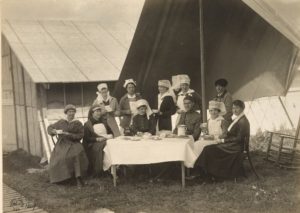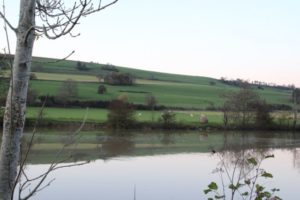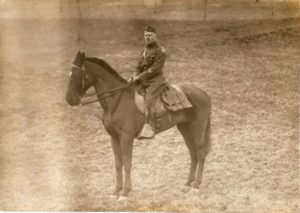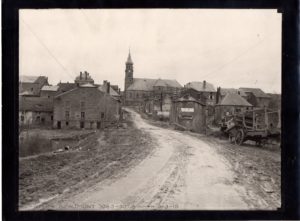by Madeleine Johnson
The Webmaster is always interest in posting reports of readers’ pilgrimage to the Meuse-Argonne and the other American battles of WW1. Thanks to Madeleine Johnson for sharing her story.
After months of “chasing the Hun,” the Occupation of Germany offered the Third Army many pleasures–a beautiful setting, Rhine wine, baseball. My great uncle, Lothar R. Long, a Captain of the 6th Machine Gun Battalion in the 4th Marine Brigade who aspired to be a journalist, particularly enjoyed newspapers and magazines from home.
He did not always like what he read, especially if it was about the war. In March 1919, he wrote home: “Anyone who ‘writes for publication’ has the contempt of all of us, if for no other reason than that, with the exception of some real newspaper people, most of the war dope published in the form of letters and narratives is bull. And the stuff that William Almon Wolff and Elizabeth Frazer write is bull. … But they must be true of course. These people have been in France, and therefore must know. And — conclusive truth — weren’t there among the illustrations pictures of the authors with helmets and mask at gas alert?”
The following week he relented: “After reading Elizabeth Frazer’s last story “The Last Fight,” I guess I ought to remove her from from the class with William Almon Wolf. It is such a brilliant word picture, in parts, of the last few days of the war that the article is really good.
Only one who had not been through the Argonne-Meuse [sic] battle could write so brilliantly about it. Such is life, and some of these jaded, blase boy-men who have gone through the middle of hell during the last year, will stack up poorly, unfavorably, dully, with the enthusiastic, fresh fourragered talkative S.O.S. soldiers who have just recently had the thrilling experience of visiting our battlefield and picking up Boche souvenirs there.
So naturally we slide into the attitude that ‘it would be better if all newspaper and magazine writers would stay the hell away from us’ and we vow that nothing we ever write home will ever get into print.”
“The Last Fight,” which appeared in the 8 February, 1919 Saturday Evening Post was Elizabeth Frazer’s report on forty-eight hours after the Armistice. She covered the Parisians’ initial reaction–deep suspicion–and a trip to the Meuse-Argonne, to see “where men got the hell and the world got the glory.”
The forty-year-old Frazer was a California native and graduate of U.C. Berkeley. She got her journalistic break while working as a nurse in France and obtained military accreditation, which was hard to get and rare among many self-appointed “war correspondents.”

Signal Corps photo 15119 taken 21 June, 1918. The caption reads: “Tea given by Miss Elizabeth Frazer of the Saturday Evening Post at the U.S. Army Evacuation Hospital #1.” The caption is unclear whether the Miss Frazer is the the woman on the left in the first or second row. NARA Record Group 111.
Taking a roundabout train and auto route from Paris, Frazer reached Beaumont, the headquarters of the 4th Marine Brigade. There she met her guide to the battlefields “Brigadier General N—–” (probably Wendell Neville, Commander of the 4th Marine Brigade.)
Frazer hoped her trip in the general’s touring car along roads that were churned to “thick custard” would show far-away readers what the French had seen up close–the “pangs her soldiers have borne: the fatigue and fear, dysentery, influenza, pneumonia and cold that cut down “magnificent kids who, soul-strong but body-weak toppled from sickness or fatigue.” Frazer described the huge traffic jams of motor lorries, ambulances or “dragged-out pack mules” that kept men hungry or without ammunition. She passed “snug” German bunkers clinging like cliff-dwellings to hillsides, woods filled with horse carcasses and ground martyred by artillery and tangles of barbed wire. Graves were everywhere, in large clusters, including one of 88, and lonelier crosses grouped in “fives and twos and one.”
When Gen. N—– and Frazer reached the point where the Marines had crossed the Meuse , Frazer scrambled down a ravine to a “shining, smiling river full of leaping trout, gliding with many serpentine twists and turns along a flat and sedgy bottom land.”
Frazer reported that blankets, rifles, helmets and ammunition littered ground that was marked with “veritable circles of blood.” “I have seen hell,” she wrote, “and I cannot forget it. I have only seen it. I have not experienced, suffered, endured it. And even then, I did not see hell in full blast. It was a restrained, half-cleaned-up, half-cold hell I saw.”
Had she been there earlier with my great uncle she would have seen “The dead were so thick you could hardly count them, armless, legless, headless bodies, half bodies, shreds of flesh, bone, clothing everywhere, half a dozen corpses around single shell craters.”
The pontoon bridge the Marines crossed was still where the 2nd Engineers had swum across under German fire to set it up. Before crossing the slippery planks that had pitched so many members of the 5th Regiment to icy deaths in the water, Frazer’s feet sank ankle-deep into the marsh on the river bank. “But it was not heaven’s dew or the bright water of the Meuse that closed bubbling over my foot. Here, just where I was standing, some American had quietly bled his life away.”
November 2014
On 10 November, 2014 I, too, followed the 4th Marine Briagde’s and Miss Frazer’s route to the Meuse. I began from the 2nd Division Boulder outside Landres-et-St. Georges that marks the division’s 1 November jump off and followed the same roads as Miss Frazer and General N—–. I didn’t have a touring car or a general for a guide, just The History of the 6th MGB and Its Participation in the Great War, written by my great-uncle and Thomas J. Curtis.
Beaumont is a handsome market town. “Man O man how they shelled and gassed us.” my great uncle wrote. Then the Marines chased the Germans who “retired in beaucoup indignty and ‘toot sweetness’ across the Meuse.”
I visited the abandoned Mouzon railroad station, where my great uncle heard the shooting stop at 11:00am on 11 November. He had just lost a good friend, who commanded a machine gun company that had only 6 men left. Despite the good news, he was “soul sick” and didn’t give “a damn if [he] got bumped off or not.”
After Mouzon, I headed up the river and then down a muddy track to the Meuse’s “German side,” which is the easiest place to see the 2nd Division boulder marking the site of the Marine’s pontoon bridge.
Often, nature has so thoroughly healed the scars of war that in the tranquil present it can be hard to imagine the brutal past. It was not hard now.
A warm autumn day was now cold dusk. I was alone. The only sound was an eddy sucking at the shore line. I stepped closer to the water’s edge to see the boulder through the rising mist and deepening dark. My feet sank into the cold, marshy shoreline. It oozed over my feet. It was not blood, like it had been for Frazer. But in the dusk on 10 November, 2014 it felt like it could have been.

Photo showing the 2nd Division Boulder where the 2nd Division Marines crossed the Meuse. Courtesy of the author.



